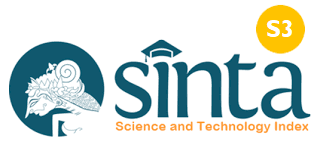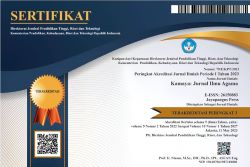Sistem Aguron-guron di Griya Agung Bangkasa Kecamatan Abiansemal Kabupaten Badung
DOI:
https://doi.org/10.37329/kamaya.v7i1.3067Keywords:
Aguron-guron, Griya Agung BangkasaAbstract
The aguron-guron system is an educational system developed by the Hindu religion to teach knowledge and skills in the religious field. The system is still highly relevant for imparting spiritual knowledge in the process of producing a pandita/sulinggih (spiritual teacher). The pandita, as a spiritual leader, holds a significant position and authority in the religious life of the Hindu community. Research related to the aguron-guron system was conducted at Griya Agung Bangkasa because this griya (household) is one of the ancient griyas with a long lineage of sulinggih and is committed to developing the aguron-guron system. There are three issues addressed in this research, namely related to the form, function, and implications of the aguron-guron system in Griya Agung Bangkasa. This qualitative research with a theological approach uses structural functionalism and symbolic interactionism theories to analyze the issues so that data can be presented descriptively qualitatively. The form of the aguron-guron system in Griya Agung Bangkasa is an education system known as "Garis Kapurusan Parampara." This education system is implemented intensively and exclusively by teachers/nabe towards their students/sisya. The aguron-guron education is carried out with the aim of achieving parartha and paramartha. The components involved include nabe, nanak, curriculum, walaka griya, and overseeing foundations. The aguron-guron system in Griya Agung Bangkasa serves educational, religious, and social functions. Lastly, regarding the implications of the aguron-guron system in Griya Agung Bangkasa, it gives rise to educational, theological, and sociological implications both internally and externally. This exclusive aguron-guron system is unique due to the presence of pawintenan wiwa and the existence of nabe siksa in the process, both of which are efforts to improve the quality of the implemented aguron-guron education. The exclusive nature of the aguron-guron system is the best choice for providing spiritual education, enriching the educational system, and creating a holistic education.
References
Ambarnuari, M. & Harsananda, H. (2023). Pandita Dalam Teks Lontar Tutur Gong Besi. Kamaya: Jurnal Ilmu Agama, 6(2):133–45.
Artha, P. E. P. (2017). Aksara Bali Dalam Pawintenan Wiwa Di Griya Agung Bangkasa Desa Bongkasa Kecamatan Abiansemal Kabupaten Badung. Denpasar: IHDN Denpasar.
Arwati, N. M. (2006). Upacara Ngaben Dadakan. Denpasar: Upada Sastra.
Darmayasa, I. M. (2014). Canakya Nitisastra. Surabaya: Paramita.
Donder, I. K. (2006). Brahmavidya: Teologi Kasih Semesta Kritik Terhadap Epistemologi Teologi, Klaim Kebenaran, Program Misi, Komparasi Teologi, Dan Konversi. 1st ed. Surabaya: Paramita.
Donder, I. K. (2009). Teologi: Memasuki Gerbang Ilmu Pengetahuan Ilmiah Tentang Tuhan Paradigma Sanatana Dharma. 1st ed. Surabaya: Paramita.
Harsananda, H. (2021). Strukturasi Ajaran Tattwa Dalam Teks Tattwa Jnana. Kamaya: Jurnal Ilmu Agama, 4(2):188–204.
Maswinara, I. W. (2003). Bhagawad Gītā; Dalam Bahasa Sanskṛta, Inggris Dan Indonesia. Surabaya: Paramita.
Mehta, R. (1999). Upanisad Menemukan Tuhan Dalam Diri. Denpasar: Sraddha.
Miartha, I. W. (2015). Diksanisasi Teogeneologis-Teoantropologis. Denpasar: Yayasan Santha Yana Dharma MGPSSR.
Miartha, I. W. (2015). Diksanisasi Teogeneologis-Teoantropologis. Denpasar: Yayasan Santha Yana Dharma MGPSSR.
Pals, D. L. (2012). Seven Theories Of Religion. 2nd ed. Jogjakarta: IRCiSoD.
Pelly, U. & Menanti, A. (1994). Teori Teori Sosial Budaya. Jakarta: Departemen Pendidikan dan Kebudayaan, Balai Pustaka.
Putrawan, N. (2010). Babad Bali Baru Sejarah Kependudukan Bali 1912 Sampai 2000. Bandung: Indah Jaya Adi Pratama.
Putu Putra, N. (2011). Tuhan Upanisad Menyelamatkan Masa Depan Manusia. Jakarta: Media Hindu.
Radhakrishnan, S. (2008). Upanisad-Upanisad Utama. Surabaya.
Ritzer, G. (2012). Teori Sosiologi Dari Sosiologi Klasik Sampai Perkembangan Terakhir Post Modern. 8th ed. Yogyakarta: Pustaka Pelajar.
Saitya, I. B. S., & Indrayani, A. D. (2020). Paṇḍita Dalam Teks Agastya Parwa. Kamaya: Jurnal Ilmu Agama, 3(3), 298-307.
Sandika, I. K. (2018). Siwa Tattwa (Ajaran Spiritual Leluhur Nusantara). Denpasar: Bali Wisdom.
Suhardana, K. ( 2008). Dasar-Dasar Kesulinggihan. Surabaya: Paramitha
Zoetmulder, P. (2011). Kamus Jawa Kuna Indonesia. Jakarta: PT. Gramedia.
Downloads
Published
How to Cite
Issue
Section
License
Copyright (c) 2024 Kamaya: Jurnal Ilmu Agama

This work is licensed under a Creative Commons Attribution-ShareAlike 4.0 International License.
An author who publishes in the Kamaya : Jurnal Ilmu Agama agrees to the following terms:
- Author retains the copyright and grants the journal the right of first publication of the work simultaneously licensed under the Creative Commons Attribution-ShareAlike 4.0 License that allows others to share the work with an acknowledgement of the work's authorship and initial publication in this journal
- Author is able to enter into separate, additional contractual arrangements for the non-exclusive distribution of the journal's published version of the work (e.g., post it to an institutional repository or publish it in a book) with the acknowledgement of its initial publication in this journal.
- Author is permitted and encouraged to post his/her work online (e.g., in institutional repositories or on their website) prior to and during the submission process, as it can lead to productive exchanges, as well as earlier and greater citation of the published work (See The Effect of Open Access).
Read more about the Creative Commons Attribution-ShareAlike 4.0 Licence here: https://creativecommons.org/licenses/by-sa/4.0/.





